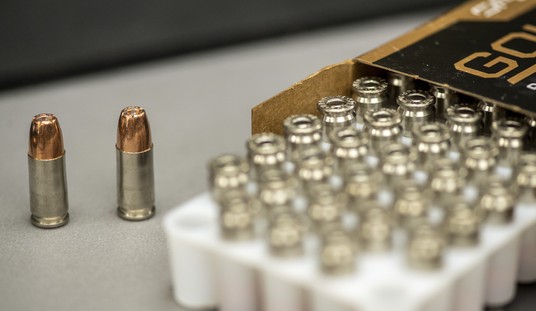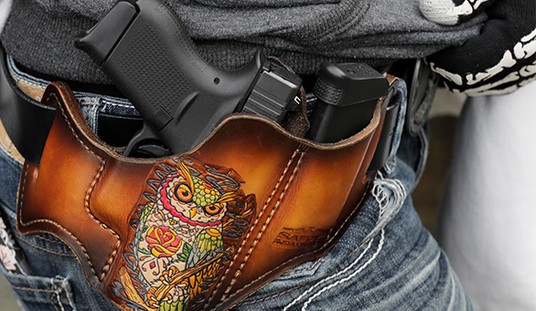Call me crazy, but when someone handed me the 12-gauge model of the new A-10 American sidelock for the first time, it evoked a $100,000 pigeon gun by the ultra-exclusive Italian firm of Tullio and Ivo Fabbri.
In fact, our experience in shooting the A-10 American sidelock over/under, in both 12 and 20 gauge, is all about the first impressions you gather in handling prototypes for a few hours on a sporting clays course.
You may have read about the A-10 Americans, but when you shoulder one and call “pull” the entire philosophy behind the revolutionary sidelock over/under crystallizes into revelation about what is now possible when a $100,000 European sidelock is exposed to some Yankee ingenuity that compresses the price to under $10,000
 |
We shot early prototypes of the A-10 American as Connecticut Shotgun Manufacturing Company (CSMC) ramps up production with initial shipments of the 12 gauge on their way to eager customers.
The prototypes loaned to us by Lou Frutuoso, the company’s sales and marketing manager, were early test mules. The 12-gauge had endured tens of thousands of rounds in an endless series of stress tests. The 20 gauge was the first one made – as evidenced by a few pieces that still needed case-color hardening. Combined, the 12 and 20 gauge A-10 Americans prototypes provided the first real opportunity to evaluate their dynamics in the field.
CSMC set the shotgun world on notice last fall when it unveiled the A-10 American at an aggressive, introductory price of under $5,000 for an over/under sidelock. It was the sidelock action that set off the fireworks.
Most production over/unders feature boxlock actions. Although boxlocks have significantly fewer parts, their dimensions tend to be bigger than sidelocks, wherein each trigger has a dedicated action mounted to the sideplate.
Over single-malt scotch and cigars, the debate still rages on the subject of the superiority of boxlock versus sidelocks. Apart from ideologies, the hard reality of the marketplace dictates that sidelocks are favored by premium English side by sides (and six-figure over/unders from Italian superstars such as Fabbri and Beretta).
Mention sidelock to a purist and the deities will be invoked: Purdey, Holland & Holland, Boss, Westley Richards and others in the pantheon of bespoke English side by sides.
With that in mind, the venue was most fitting for our field assessment of the A-10 prototypes. We shot them at the 8th Annual American Side by Side Classic held June 4-6 at Hausmann’s Hidden Hollow Sporting Clays in Friendsville, Pennsylvania.
Situated in the leafy Endless Mountains of Susquehanna County, proprietor Ernie Hausmann integrates the terrain for presentations in the spirit of Hunter Clays, which adheres to the origins of sporting clays to create the realistic flight of game birds as opposed to the current craze in sporting clays that pits trap setter against shooter with extreme target acrobatics that flout the world of feathered creatures.
Sidelock purists would also have approved of the shotshells we used. Classic Shotshell Co. provided us with their RST low-recoil Falcon Ultra Lite 2-½ inch, ¾-ounce, 7½ loads in 12 gauge. For the 20-gauge A-10, we shot RST’s 2¾-inch, 7/8-ounce Lite loads stuffed with #8 shot and #7½ shot.
RST has become the standard for vintage shotgun owners obliged to shoot low-recoil, low-pressure ammo through their 100-year-old barrels. Since many vintage shotgun owners compete in events such as the 8th Annual American Side by Side Classic, RST’s shotshells are prized for their unsurpassed patterning.
The stage was now set for us to gather first impressions of the A-10 American prototypes under conditions that best simulated the typical sidelock owner setting out for a day of upland hunting.
But before we share our impressions of the A-10 American prototypes, let’s lay a foundation with some background about these distinctive sidelock over/unders.
When introduced in the fall of 2009, the A-10 American thrust the U.S. into the sidelock segment dominated by the Europeans. Tony Galazan, owner of CSMC, wanted the A-10 American to represent the ideal that just about any American wingshooter could enjoy a sidelock similar to those that frequent the grand shooting estates of England.
Beyond the obvious snob appeal, the sidelock opens a new world of design possibilities when applied to over/unders.
You’d be hard pressed to find a more streamlined over/under than the A-10 American, with the exception of the Blaser F3. Blaser achieved the stunning F3 low profile via an innovative, in-line hammer and extremely thin yet powerful lock-up. Really, the only other way a shotgun manufacturer could match the slender dimensions of an F3 would be with a sidelock. The problem then translates into making a sidelock affordable for a bigger audience that in turn fuels greater economies of scale.
With two actions and more components than a boxlock, sidelocks have traditionally risen above the fray in the arena occupied by shotguns costing between $5,000 and $10,000. But CSMC enjoys a reputation for shattering price barriers with its long-running RBL side by side.
If anyone was going to bring a sidelock into the hands of upland enthusiast everywhere, it would be Tony Galazan and the boys at CSMC.
The philosophy, culture and know-how already existed at CSMC to make and market firearms that hark back to the golden age of shotgunning when sidelocks were filling stew pots for supper. CSMC manufactures reproductions of American classics such as A.H. Fox, the Winchester Model 21 and the original Parkers.
Still, the stakes were high for CSMC when it came to the A-10 American. Devotees bemoan that sidelocks have become a dying art form outside the rarified world of bespoke, six-figure masterpieces (unless of course you buy yourself an old, derelict specimen). The marketplace would not cut CSMC any slack just because it brought out an affordable sidelock. While shooters may settle for a cheap boxlock, no one wants to buy a new, second-rate sidelock at any price. The A-10 American would have to stand on its own in terms of value, quality and features.
For starters, the A-10 American employs CSMC’s Hard Gold system on the internal components of this four-pin sidelock. Gold resists corrosion and is typically found on pricier sidelocks. The action features V main springs and safety sears that facilitate smooth and reliable trigger pulls.
When it comes to maintenance, we recall the days of the British Empire when sidelocks enabled quick upkeep in the equatorial colonies of India, Africa and the Caribbean. Back in the days of the pith helmet, a screw on the sideplate could be unfastened by hand, exposing the actions on both triggers. The A-10 American modernized the approach with a flush pop-up release that becomes nearly invisible on the sideplate.
To sustain barrel integrity, CSMC applied its Cryo Pattern process, which deep freezes the barrel to remove stress. The bores are then coated with CSMC’s Tuff Bore process that accommodates steel shot. Each barrel comes with five Trulock chokes.
The A-10 American features automatic ejectors, a single selective trigger that is adjustable to three set-point positions.
All 12-gauge models include a system for altering balance and weight to the shooter’s preference. The system has a weight hanger between the barrels under the forend and another weight adjustment in the stock. On paper, the A-10 looked and sounded intriguing.
Finally, it came time for us to shoot the prototypes.
We started with the 12 gauge, taking it to the course late in the afternoon on the first day of the competition. In the field, our prototype felt butt heavy with a balance point slightly behind the trunnions. This obviously could be tailored to the individual owner by fine tuning the weight system. Once recognized, the balance glitch didn’t really persist as a hindrance. Weighing 8¼ pounds, the pigeon-gun heft made our prototype quite manageable for just about any type of target – enhanced by the semi-beavertail forend.
The forend’s contour let us easily apply more of a front emphasis through a highly controllable hold – communicating that ideal of evenly distributed weight between the hands during the few hours that we had possession of the shotgun.
While we didn’t have the chance to pattern it, our 12-gauge A-10 American shot where you pointed it. The point of impact may have been 60/40, but it felt 50/50.
We enjoyed the short length of pull on our 12-gauge prototype. At 14 inches, the shotgun shouldered nicely, taking into account its rearward predisposition. Again, the forend let us compensate for the imbalance with more forward controllability. For future owners this is a moot point since you can order an A-10 to fit.
The trigger was an absolute sweetheart. With a pull of about 4¼ pounds, it was buttery smooth: no creep, no slack, no surprises. The A-10 American clearly fell into the pro-sidelock camp that argued for enhanced trigger feel and performance over a box lock – especially at this price.
Based on our experience shooting the 12-gauge prototype, we would order an A-10 American without the weight system and with the lighter weight, straight, English stock.
That would bring the 12 gauge down to some 7¾ pounds with 30-inch barrels. For an additional $1,200, the CSMC Custom Shop could cut the wood to your own measurements. Bottom line is that you may very well own a lovely A-10 American 12-gauge sidelock for under $10,000.
Early the next morning we were back on the course with the 20-gauge version of the A-10 American prototype. This particular example was the first one ever made. It was furnished with a straight stock that measured a 14¾-inch length of pull. Coupled with its slender forend, the shotgun expressed the hunting style of A-10 American that could be ordered from CSMC in either 12 or 20 gauge.
Our 20 gauge was fitted with 32-inch barrels that seem to be de rigueur on subgauges these days to help manage the whippy swing inherent in lighter shotguns. Unlike the 12 gauge, the 20-gauge A-10 American is not available with the weight system.
CSMC really optimized the compact attributes of the sidelock on the 20 gauge by shrinking the dimensions of the receiver down below those of the svelte, 28-gauge Perazzi MX28, explained Mr. Frutuoso. The receiver on the 20-gauge A-10 American measured a mere 3/8 of an inch wider than the over/under barrels. The entire form factor from the straight stock to the slim action elevated it to the supermodel of 20 gauges.
The length of pull was too long for me on the 20 gauge. I compensated by shifting from a low mount to drop mount where the butt plate rests on your shoulders but the comb is dropped slightly from the cheek. Once I figured out that this was the best way for me to shoot it with that 14¾-inch length of pull, I started to crush some targets.
The 20-gauge model shared the same stunning trigger as the 12 gauge and given the pleasing dimensions of this slender beauty a fully finished production model could easily be a joy to shoot. The A-10 American 20 gauge exuded a sense of competence that let you take your time with the birds. If you established the line of the target, the 20 gauge did the rest of the work for you with aplomb.
Prices for the 20 gauge A-10 American start at about $500 higher than the 12 gauge, and given the wide range of options available from CSMC the sky’s the limit when it comes to writing a check. Again, though, if you want to keep the price under $10,000 this would be a hard shotgun to beat in terms of value and execution based on the prototypes we shot of America’s new, production sidelock.
Editor’s Note: Like shotguns? Then visit shotgunlife.com.







Join the conversation as a VIP Member